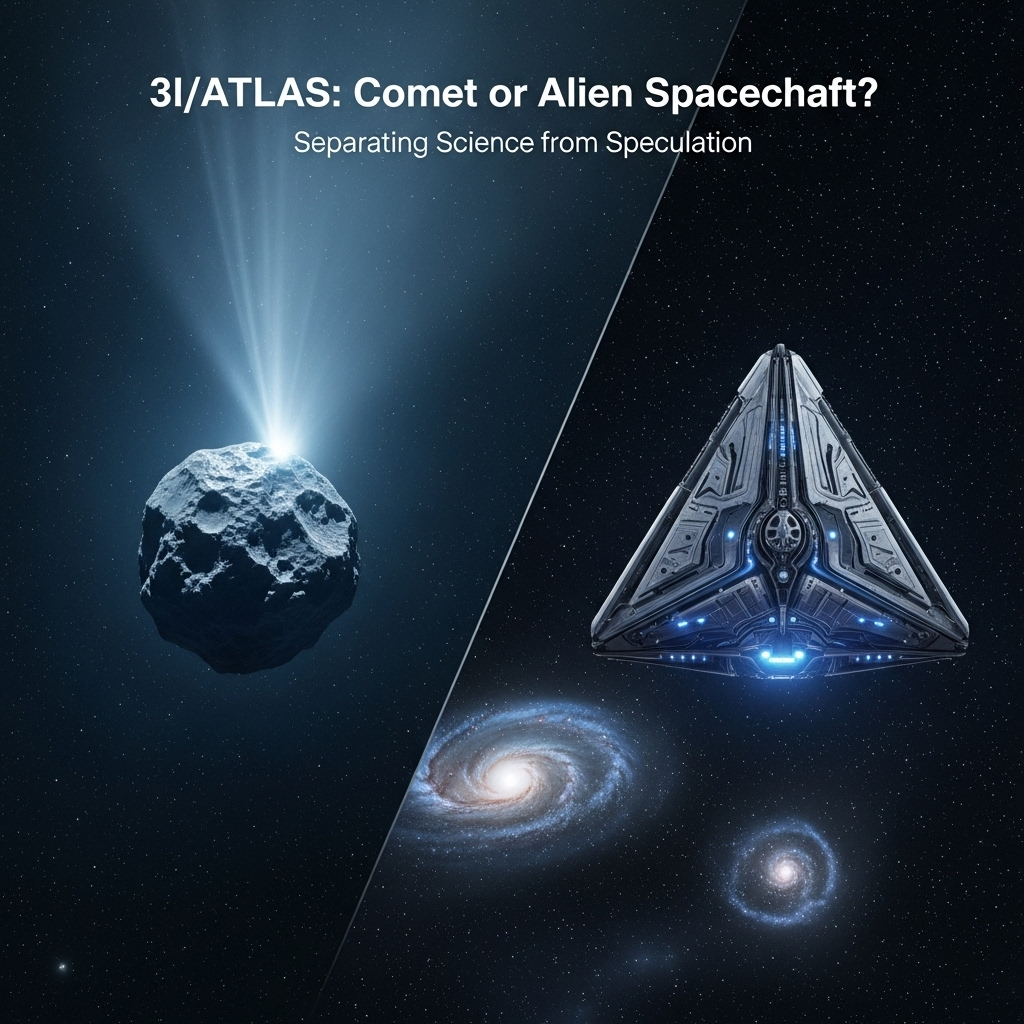Is 3I/ATLAS a Comet or an Alien Spacecraft? Separating Science from Speculation

In recent years, interstellar objects passing through our solar system have captured both scientific interest and public imagination. The third known interstellar object, designated 3I/ATLAS (C/2024 L5), has sparked renewed debate: is it merely a natural comet—or could it be something more exotic, like an alien spacecraft?
Let’s examine the facts, the context, and why scientists overwhelmingly favor the natural explanation.
What Is 3I/ATLAS?
Discovered in June 2024 by the ATLAS (Asteroid Terrestrial-impact Last Alert System) survey in Hawaii, 3I/ATLAS was quickly identified as having a hyperbolic orbit—an open trajectory indicating it originated outside our solar system. This makes it only the third confirmed interstellar visitor after ‘Oumuamua (1I/2017 U1) and Borisov (2I/Borisov).
Initial observations revealed:
- A faint, diffuse coma (atmosphere) surrounding its nucleus.
- A tail of gas and dust—classic hallmarks of cometary activity.
- No artificial radio signals or structured emissions detected.
These characteristics strongly suggest that 3I/ATLAS is a comet, not a spacecraft.
Why Do Some Think It Might Be Artificial?
The idea that interstellar objects might be alien probes stems largely from the peculiar behavior of ‘Oumuamua—the first interstellar visitor. Its elongated shape, non-gravitational acceleration, and lack of visible outgassing led some (notably Harvard astronomer Avi Loeb) to propose an artificial origin.
When 3I/ATLAS appeared, online speculation surged again. However, unlike ‘Oumuamua, 3I/ATLAS displays textbook cometary features:
✅ Visible coma and tail
✅ Spectroscopic signatures of water vapor, CO₂, and dust
✅ Predictable acceleration due to sublimating ices (outgassing)
✅ No anomalous radar reflections or structured geometry observed
In short: 3I/ATLAS behaves exactly like a comet should.
Scientific Consensus
The astronomical community remains confident in the natural interpretation. Comets from other star systems are not only plausible—they’re expected. Models of planetary formation suggest that most stars eject countless icy bodies into interstellar space during their early evolution.
Detecting three such visitors within less than a decade actually confirms theoretical predictions—not anomalies requiring extraterrestrial explanations.
Moreover, no credible evidence of artificial structure, propulsion, or technology has been found on or around 3I/ATLAS. SETI (Search for Extraterrestrial Intelligence) observations conducted as it passed near Earth detected no signals.
Why Does the “Alien Spacecraft” Idea Persist?
Humans are pattern-seeking creatures. When faced with rare or poorly understood phenomena, we sometimes default to extraordinary explanations. Media headlines amplify this tendency, often prioritizing mystery over method.
But science demands evidence—and so far, Occam’s Razor applies: the simplest explanation (a dirty snowball from another star) fits all the data.
That doesn’t mean we shouldn’t remain curious. Future missions, like the proposed ESA Comet Interceptor or Breakthrough Starshot concepts, may one day rendezvous with such objects to study them up close.
Conclusion
3I/ATLAS is almost certainly a comet—a fascinating, pristine relic from another planetary system. While the possibility of alien technology can’t be ruled out absolutely (science rarely deals in absolutes), there is currently zero empirical support for such a claim.
Rather than speculating about spacecraft, we should celebrate what 3I/ATLAS truly represents: our growing ability to detect and study visitors from beyond our cosmic neighborhood. Each interstellar object offers clues about how planetary systems form, evolve, and interact across the galaxy.
The universe is strange enough without needing aliens—but if they ever do show up, we’ll know. And 3I/ATLAS isn’t it.
—
Further Reading:
- NASA JPL Small-Body Database: 3I/ATLAS
- “Interstellar Comets: What We’ve Learned So Far” – The Astrophysical Journal, 2025
- ESA’s Comet Interceptor Mission Overview
Note: As of current knowledge (April 2025), 3I/ATLAS remains classified as an interstellar comet with no credible evidence suggesting artificial origin.




